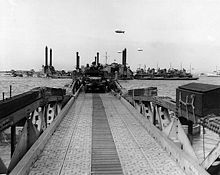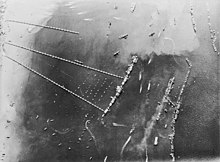Mulberry ports
The Mulberry ports were two artificial supply ports built by the Allies on the coast of Normandy ( Calvados department ) during World War II . The ports were designed by the two engineers Ove Arup and Ronald Jenkins .
planning
The planning of the Supreme Headquarters Allied Expeditionary Force provided for the construction of two large landing stages for transport ships as part of Operation Overlord after the successful landing in Normandy . Mulberry "A" should be in front of Vierville-sur-Mer ( Omaha Beach ) by the Americans and Mulberry "B" ( location ) before Arromanches ( Gold Beach ) to be built by the British . The individual parts were prefabricated in England and then put together off the coast of Normandy.
Description and commissioning
The principle was the same for both ports. They should offer protection from the rough sea and allow ships to be unloaded despite the tidal range . The former could be achieved by the use of caissons and the self- sinking of older ships, which created an artificial reef around the harbor where the waves broke. Further out at sea, large metal structures known as bombardons were anchored, which also served to weaken the waves. For a "round-the-clock discharge" the piers had to move up and down with ebb and flow . Caesar boxes with long metal posts were also used for this. On these the pier heads slid up and down with the tide. The road system for transporting the supplies in the port covered around 500 hectares .
On land, the Allies built large warehouses and vehicle fleets. Old roads were widened and new ones laid out for faster transport of goods to the front.
Construction of the two ports began on June 7, 1944, one day after the landing. The first ships could be unloaded after just three days. Completion should be on June 20th. A violent storm that began on June 19 and only weakened after three days almost completely destroyed Mulberry "A", which had not yet been secured according to the specifications. The Americans waived the repair, so that the parts that could still be used were used to complete the slightly damaged Mulberry "B" port. At Vierville-sur-Mer / Saint-Laurent-sur-Mer , however, the Americans still unloaded transport ships on land, which later turned out to be even more effective than unloading at sea.
The British port of Mulberry "B" went into full operation shortly afterwards. A total of 628,000 tons of supplies, 40,000 vehicles and 220,000 soldiers had been brought ashore here by October 31.
photos
- Remains of the Mulberry "B" plant in Arromanches-les-Bains
See also
literature
- J. Evans, E. Palmer, and R. Walter: A Harbor Goes to War: The Story of Mulberry and the Men Who Made It Happen. Brook House, 2000, ISBN 1-873547-30-7 .
- Guy Hartcup: Code name Mulberry: The planning, building, and operation of the Normandy harbors. Hippocrene Books, 1977, ISBN 0-88254-443-8 .
Web links
- Mulberry Harbor ( Memento from February 10, 2013 in the web archive archive.today )
- Supreme Headquarters Allied Expeditionary Force (1944): Report on Mulberry "B" (English)
- Normandie Mémoire Association: The artificial harbors
- Haber, Saskia Regina: How a mulberry won the war . Master thesis, University of Vienna. Faculty of History and Cultural Studies, 2016. PDF file, 6 MB






